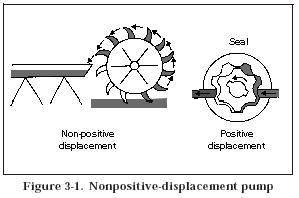All pumps create flow. They operate on the displacement principle. Fluid is taken in and displaced to another point. Pumps that discharge liquid in a continuous flow are nonpositive-displacement type. Pumps that discharge volumes of liquid separated by periods of no discharge are positive-displacement type.
Nonpositive-Displacement Pumps. With this pump, the volume of liquid delivered for each cycle depends on the resistance offered to flow. A pump produces a force on the liquid that is constant for each particular speed of the pump. Resistance in a discharge line produces a force in the opposite direction. When these forces are equal, a liquid is in a state of equilibrium and does not flow.
If the outlet of a nonpositive-displacement pump is completely closed, the discharge pressure will rise to the maximum for a pump operating at a maximum speed. A pump will churn a liquid and produce heat. Figure 3-1 shows a nonpositive-displacement pump. A water wheel picks up the fluid and moves it.
Positive-Displacement Pumps. With this pump, a definite volume of liquid is delivered for each cycle of pump operation, regardless of resistance, as long as the capacity of the power unit driving a pump is not exceeded. If an outlet is completely closed, either the unit driving a pump will stall or something will break. Therefore, a positive- displacement-type pump requires a pressure regulator or pressure-relief valve in the system. Figure 3-2, shows a reciprocating-type, positive-displacement pump.
Figure 3-3, shows another positive-displacement pump. This pump not only creates flow, but it also backs it up. A sealed case around the gear traps the fluid and holds it while it moves. As the fluid flows out of the other side, it is sealed against backup. This sealing is the positive part of displacement. Without it, the fluid could never overcome the resistance of the other parts in a system.
Characteristics. The three contrasting characteristics in the operation of positive- and non positive-displacement pumps are as follows:
• Nonpositive-displacement pumps provide a smooth, continuous flow; positive displacement pumps have a pulse with each stroke or each time a pumping chamber opens to an outlet port.
• Pressure can reduce a nonpositive pump’s delivery. High outlet pressure can stop any output; the liquid simply recirculates inside the pump. In a positive displacement pump, pressure affects the output only to the extent that it increases internal leakage.
• Nonpositive-displacement pumps, with the inlets and outlets connected hydraulically, cannot create a vacuum sufficient for self-priming; they must be started with the inlet line full of liquid and free of air. Positive-displacement pumps often are self-priming when started properly.


